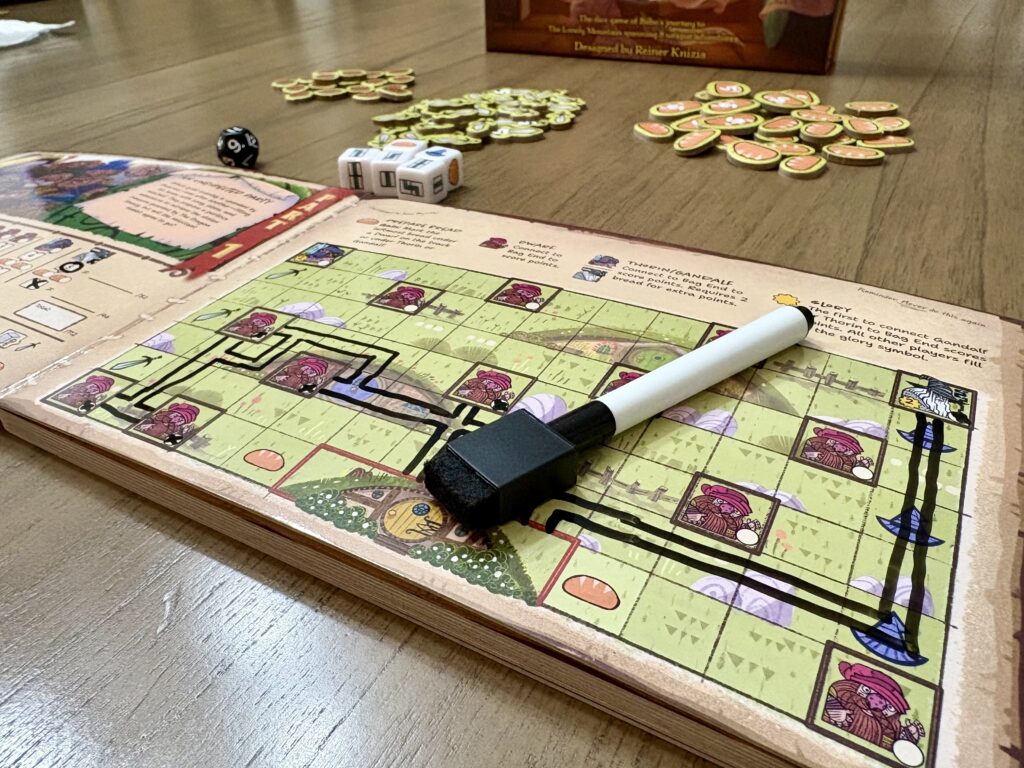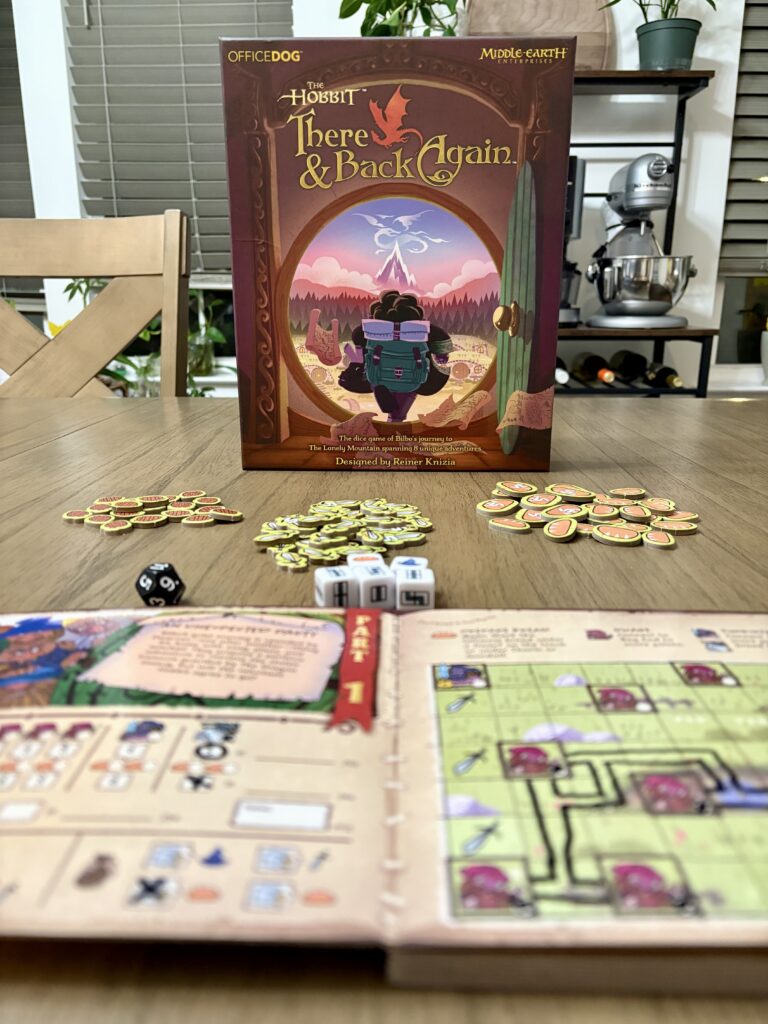Welcome to this week’s review! This week I’m taking a look at a recent Lord of the Rings themed roll-and-write. So without further ado, let’s jump into it.
Disclosure: A review copy of this game was provided to The Meeple Digest in exchange for an honest, unbiased review. This review is not intended to be an endorsement.
The Hobbit: There and Back Again
- Designer: Reiner Knizia
- Publisher: Office Dog
- Complexity: Light
- Time: 30 Minutes
- Players: 1-4
- Main Mechanisms: Roll-and-Write
The Hobbit: There and Back Again is a roll-and-write from designer Reiner Knizia, best known for designing games such as Ra, The Quest for El Dorado, Tigris & Euphrates, and many others. There are eight different scenarios that take players through events from The Hobbit. These scenarios can be played in any order, although I personally choose to play through them in story order, and can be replayed as often as players enjoy.

At the core, players roll a set of five dice that have both polynomial shapes and resources. Then players take turns drafting dice and either drawing the matching shape on their player board and/or collecting resources. Each scenario has its own map, an objective that triggers the end of the game, such as connecting two locations, as well as some additional rule changes. Overall, while the changes are not drastic between scenarios, I enjoyed how each one offered a unique twist to the core formula. For example, my favorite scenario so far involved replacing the five main dice with a 12-sided die that had players placing polynomial shapes on a map akin to something from Tetris. In addition, even though each scenario has its own set of rule changes, it didn’t take much time to learn the differences and jump right in.
Another aspect that I found compelling revolved around deciding whether to race towards the end-goal or spend more time collecting other aspects. Each scenario has a main goal that triggers the end of the game, and often the player who triggers it receives a few extra points. For example, the goal might be to connect two locations on the map via paths. However, players earn the majority of their points from other objectives, such as the number of other types of spaces connected or by having a certain number of resources at the end of the game. In addition, some maps are divided into regions, and once a player crosses over into the next region, they are no longer able to mark any spaces in any of the previous regions. This can create some tense decisions of when to push towards the end versus stopping to finish all of the side quests along the way. Much of the decision is also dictated by what other players are doing, as you’ll need to pay attention to tell if another player is close to triggering the end of the game. In the end, much of the game is about maximizing your turns and accepting some tradeoffs.
Compared to some of the heavy euros I’ve been playing, I was pleasantly surprised by how easy it was to jump right in. I already mentioned that there aren’t too many rules and they were all fairly straightforward. In addition, there’s practically no setup involved. Players just need to open their player board to the correct scenario, put out a few resources, read a few rules specific to that scenario, and then jump in. It’s also an easy teach that feels approachable to a wide variety of gamers.
It’s also worth mentioning that the artwork and components are top notch, and again, the artwork style feels like the game is catering to a wide audience.

I mentioned needing to pay attention to what others are doing, but overall, there is very little interaction between players. Each player has their own map they draw on, and the only real interaction is from drafting the dice, as well as a few instances where the first player to accomplish an objective will receive a few points. Therefore, while the game supports up to four players, adding more players doesn’t really change the feeling of the game, except for adding additional playtime since players draft dice in turn order. Personally, I’ll likely stick to playing the game at two players only. There is a solo mode included, but each scenario has a round limit that I feel takes away from that player decision making I mentioned earlier.
While there are eight different scenarios, I did enjoy some of them more than others. This leads into my final point; I’m not sure I have any desire to return to the scenarios once I finish all of them. Part of that is likely due to my own personal tastes in board games because I suspect that this game will appeal to a wide variety of gamers. However, ultimately there aren’t enough compelling elements that would make me want to return. I still have a couple of scenarios to try, so my thoughts could always change, but I suspect that I will move on after playing through them all.

Overall, I enjoy how easy it is to pick up and play The Hobbit: There and Back Again. And while the ruleset is relatively small, I enjoy how each scenario mixes things up and the wide audience the game appeals to (having a Lord of the Rings theme never hurts). Personally though, I don’t think it’s enough to land a permanent spot in the collection.
With that, I’ll wrap up this week’s review! If you’ve played The Hobbit: There and Back Again, I’d love to hear your thoughts on the game and if you all have any other favorite roll-and-write or Lord of the Rings themed games! I’d love to hear your thoughts on any of the games I’ve mentioned or future content suggestions in the comments below. Happy gaming!
If you liked this post and want to be notified when new content is released, then follow me on Instagram @themeepledigest.

Leave a Reply